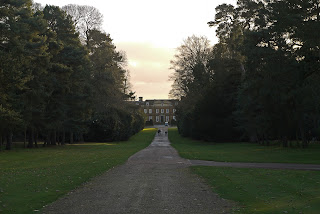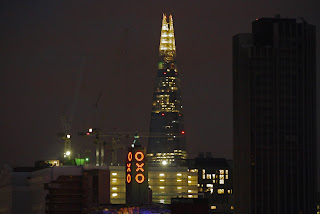The Coronet
After a packed Christmas period and extensive rain we saw today as the first opportunity for a while to get out for a walk. But walking in the country would inevitably still be wet and muddy so it came to me that we could go into London and do a city walk instead. We picked this one from the excellent London's hidden walks (vol 1) by Stephen Millar which we used to walk around Southwark in June.
The walk begins at Notting Hill Gate tube station - the "gate" was apparently a toll gate - and continues west past the wonderful Coronet cinema, originally a theatre, dating from 1898. The colour scheme and neoclassical decoration put me in mind of St Petersburg.
Soon you turn right to reach Ladbroke Sq, part of the vast Ladbroke estate of imposing houses built from the 1820s onwards.
On the side of a large house as you enter the square is this striking memorial to "Jan Palach and those who died for a free Czechoslovakia". Nobody my age will easily forget Palach setting himself on fire in 1969.
You soon reach Ladbroke Grove and the striking St John's church of 1845. The area around it had briefly been used as the Hippodrome race course during a pause in the development of this part of west London and the influence of the race course remains in the street pattern and one or two street names.
Heading further west you reach Potter St, where our eye was caught by the brickwork of the courtyard by the St Francis of Assisi church of 1860.
This was at the limit of the Ladbroke estate and the area beyond was used for pig farming and pottery manufacture. Surprisingly, a bottle kiln remains on the edge of a small 1960s housing development.
Now heading back north east, you soon reach the handsome - and very expensive - Elgin Crescent.
This extends almost all the way to Portobello Road, becoming a bit more run-down as it gets closer. We walked up and down Portobello Road to see this lively street for the first time. We were struck by how many foreign tourists there were - presumably it must be on the must-see lists of tourist guides to London. The French at least would be at home with the number of crepe stalls.
We resisted their temptations, but sheltered from a sharp shower in a very nice cafe. Towards the other end of Portobello Road is the Electric Cinema - England first purpose-built cinema, dating from 1911.
Nearby is the original of the Travel Bookshop from the film Notting Hill. I confess I don't see the appeal of spotting film sights, but we had a quick look and had to move out of the way to allow a group of tourists to take pictures of each other in front of it.
Not far away, we came to the Tabernacle in Powis Sq. It dates from the 1880s and was originally an evangelical place of worship. It is now a music venue, bar and restaurant.
Round the corner is the pretty St Luke's Mews, notorious for being where Paula Yates died.
The final section of the walk was a bit under-whelming. We walked up to Tavistock Cresent past Jade Jagger's shop and reached Portobello Road again, moving in to a sort of Spanish quarter, with a celebrated delicatessen and a Spanish School, located behind prison-like walls in a former Franciscan convent.
Our guide explains that the Spanish presence in the area dates from the arrival of refugees from the Spanish Civil War in the late 1930s.
Further up we eschewed the opportunity to photograph Erno Goldfinger's horrific Trellick Tower - the awful tower block you see from the train going into Paddington, with the semi-detached lift shaft. I know it is now a Grade II listed building, but it remains to my mind a symbol of the horrors of Brutalist architecture.
The final point of note was the Carmellite Convent of the Most Holy Trinity, dating from 1878. We ended the walk at Ladbroke Grove.
Distance: four miles.
Conditions: cloudy but bright in parts, a couple of showers.
Rating: three stars. Interesting in parts and reveals a lot about the growth of London in the 19th century. To my mind, too many of the points of note concerned people who chanced to live there, rather than the intrinsic merits of the buildings themselves.
From: London's hidden walks (vol 1) by Stephen Millar (Metro Publications).
































































